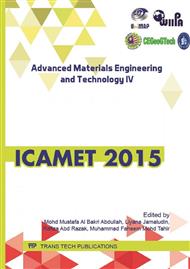[1]
Amagai, M., M. Watanabe, M. Omiya, K. Kishimoto, and T. Shibuya, Mechanical Characterization of Sn–Ag-Based Lead Free Solders. Microelectronics Reliability 2002. 42: pp.951-966.
DOI: 10.1016/s0026-2714(02)00017-3
Google Scholar
[2]
Alam, M.E., S.M.L. Nai, and M. Gupta, Development of High Strength Sn–Cu Solder Using Copper Particles at Nanolength Scale. Journal of Alloys and Compounds, 2009. 476: pp.199-206.
DOI: 10.1016/j.jallcom.2008.09.061
Google Scholar
[3]
Tsao, L.C., M.W. Wu, and S.Y. Chang, Effect of TiO2 nanoparticles on the microstructure and bonding strengths of Sn0. 7Cu composite solder BGA packages with immersion Sn surface finish. Journal Material Science: Material Electronic, 2012. 23: p.681.
DOI: 10.1007/s10854-011-0471-1
Google Scholar
[4]
Gain, A.K., Y.C. Chan, and W.K.C. Yung, Effect of additions of ZrO2 nano-particles on the microstructure and shear strength of Sn–Ag–Cu solder on Au/Ni metallized Cu pads. Microelectronics Reliability, 2011. 51: p.2306–2313.
DOI: 10.1016/j.microrel.2011.03.042
Google Scholar
[5]
X. Wang, Y.C. Liu, C. Wei, H.X. Gao, P. Jiang, and L.M. Yu, Strengthening mechanism of SiC-particulate reinforced Sn–3. 7Ag–0. 9Zn lead-free solder. Journal of Alloys and Compounds, 2009. 480: p.662–665.
DOI: 10.1016/j.jallcom.2009.02.002
Google Scholar
[6]
Chuang, T.H., M.W. Wu, S.Y. Chang, S.F. Ping, and L.C. Tsao, Strengthening mechanism of nano-Al2O3 particles reinforced Sn3. 5Ag0. 5Cu lead-free solder. Journal Material Science: Material Electronic, 2011. 22: pp.1021-1027.
DOI: 10.1007/s10854-010-0253-1
Google Scholar
[7]
Tsao, L.C., and S.Y. Chang, Effects of Nano-TiO2 additions on thermal analysis, microstructure and tensile properties of Sn3. 5Ag0. 25Cu solder. Materials and Design, 2010. 31: p.990–993.
DOI: 10.1016/j.matdes.2009.08.008
Google Scholar
[8]
An, T., and F. Qin, Effects of the intermetallic compound microstructure on the tensile behavior of Sn3. 0Ag0. 5Cu/Cu solder joint under various strain rates. Microelectronics Reliability, 2014. 54(5): pp.932-938.
DOI: 10.1016/j.microrel.2014.01.008
Google Scholar
[9]
Tsao, L.C., C.P. Chu, and S.F. Peng, Study of Interfacial Reactions Between Sn3. 5Ag0. 5Cu Composite Alloys and Cu Substrate. Microelectronic Engineering, 2011. 88: pp.2964-2969.
DOI: 10.1016/j.mee.2011.04.034
Google Scholar
[10]
Nai, S.M.L., J. Wei, and M. Gupta, Interfacial intermetallic growth and shear strength of lead-free composite solder joints. Journal of Alloys and Compounds, 2009. 473: pp.100-106.
DOI: 10.1016/j.jallcom.2008.05.070
Google Scholar


